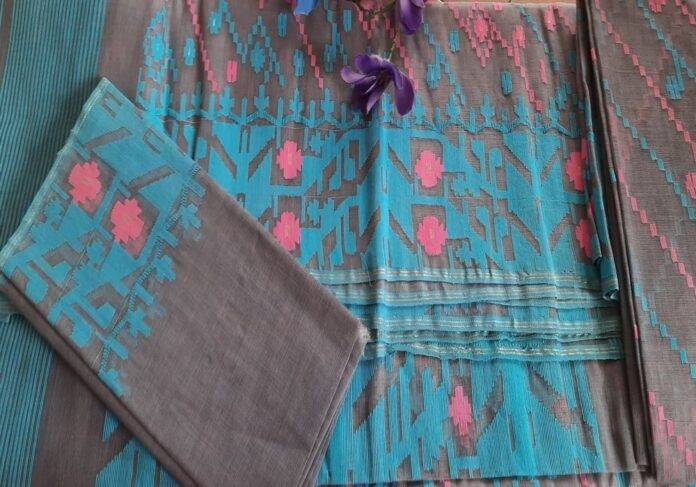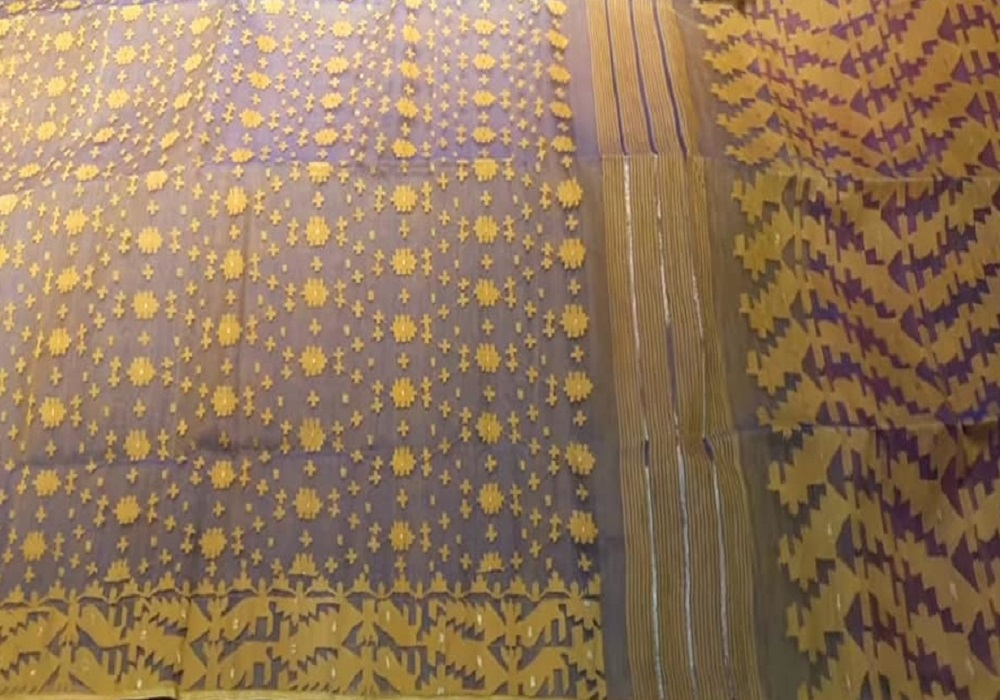Jamdani Saree
Jamdani saree, an epitome of artistry and craftsmanship, is one of the most beautiful and prized possessions in the world of textiles. Originating from the Indian subcontinent, particularly Bangladesh and parts of West Bengal, India, Jamdani sarees have earned global recognition for their intricate weaving patterns, lightweight texture, and ethereal beauty.
Historical Significance and Origin
Dating back to the Mughal era, Jamdani sarees were patronized by nobility and royalty for their exquisite craftsmanship. The name “Jamdani” is thought to have come from the Persian words “Jam,” which means flower, and “Dani,” which means vase. This name is a perfect fit for the floral designs covering these sarees.
The Art of Weaving Jamdani Sarees
Crafting a Jamdani saree is an intricate and time-consuming process. It involves traditional handlooms and skilled weavers who meticulously create unique patterns by interlacing cotton or silk threads with a fine muslin cloth. This art form has been passed down through generations, preserving its authenticity and allure.
Types of Jamdani Sarees
Traditional Jamdani
Traditional Jamdani sarees boast centuries-old weaving techniques and patterns deeply rooted in the culture of Bengal. These sarees often feature classic motifs like floral vines, birds, and geometric designs, showcasing the artisans’ mastery.
Dhakai Jamdani
Hailing from the historic city of Dhaka, these sarees are renowned for their sheer elegance and delicacy. The complex patterns on Dhakai Jamdani sarees are a well-renowned and artistic blend of vibrant colors, reflecting the region’s cultural heritage.
Shantipur Jamdani
Originating from Shantipur, West Bengal, Shantipur Jamdani sarees are characterized by bold and distinct patterns. Weavers here skillfully incorporate traditional motifs with contemporary designs, resulting in exquisite creations that are highly sought after.
Dhonekhali Jamdani
Dhonekhali, a town in West Bengal, produces Jamdani sarees with intricate motifs inspired by nature and mythology. These sarees often feature artistic renditions of animals, trees, and scenes from mythology, making them truly unique and captivating.
Popular Jamdani Patterns and Designs
Jamdani sarees exhibit diverse patterns, from floral motifs to geometric shapes, paisleys, and mythical figures, all carefully woven by master artisans. Each pattern tells a story, and the skillful use of colors and threads creates a mesmerizing effect that sets Jamdani sarees apart from other textiles.
Materials Used in Jamdani Weaving
The primary materials used in Jamdani weaving are high-quality cotton and silk threads, ensuring the sarees’ softness, sheen, and comfort. These natural fibers are carefully sourced and dyed to achieve the desired color palette, enhancing the overall appeal of the sarees.
The Significance of Jamdani Sarees in Different Cultures
Jamdani sarees hold deep cultural significance and are often worn during special occasions, festivals, and weddings in Bangladesh and India. They are not just garments but symbols of tradition, heritage, and a sense of belonging to one’s roots.
In Bangladesh, Jamdani sarees are integral to the country’s cultural identity. They are proudly worn during national celebrations and events, representing the nation’s rich artistic heritage. In India, particularly in West Bengal, Jamdani sarees are cherished as a traditional attire that connects the present generation with the historical splendor of the past.
Jamdani Sarees in Contemporary Fashion
Recently, Jamdani sarees have returned to the global fashion scene, with designers incorporating these exquisite weaves into modern styles. The fusion of traditional Jamdani patterns with contemporary silhouettes has captured the attention of fashion enthusiasts worldwide.
Fashion shows and runways have witnessed models adorned in stunning Jamdani sarees, attracting a broader audience and promoting the cultural legacy of this beautiful textile. Celebrities and fashion influencers have also contributed to the popularity of Jamdani sarees by donning them at various red-carpet events and social gatherings.
Caring for Jamdani Sarees
To preserve the beauty and longevity of a Jamdani saree, it is essential to handle it carefully and follow proper cleaning and storing methods. Here are some tips for maintaining these delicate and precious garments:
- Dry Cleaning: Select specialized dry cleaning services to protect the saree’s fragile fibers.
- Avoid Direct Sunlight: Keep Jamdani sarees out of direct sunlight and a dry environment to prevent color fading.
- Gentle Washing: If hand washing is necessary, use mild detergent and gently wash the saree in cold water.
- Avoid Wrinkling: Fold the saree carefully and avoid pressing it with heavy objects to prevent wrinkling.
- Avoid Perfumes and Deodorants: Keep the saree away from direct contact with perfumes and deodorants to avoid stains.
Where to Buy Authentic Jamdani Sarees
Authentic Jamdani sarees can be found in traditional textile markets, renowned showrooms, and online stores. However, buyers must be cautious to avoid counterfeit products. Reputable sellers and established brands with a history of selling authentic handloom sarees are the best places to purchase.
The Growing Global Demand for Jamdani Sarees
Jamdani sarees’ timeless charm and intricate craftsmanship have increased demand worldwide, making them a symbol of luxury and heritage. International buyers are drawn to these sarees’ elegance and unique appeal, making them highly sought after in the global market.
Designers and fashion enthusiasts worldwide are incorporating Jamdani sarees into their collections, appreciating the skill and artistry of the weavers behind each creation. This growing global demand has opened up new opportunities for weavers and artisans, ensuring the preservation of this traditional art form for future generations.
Jamdani Saree as a Symbol of Bangladeshi Heritage
The Jamdani saree represents the rich cultural heritage of Bangladesh and is cherished as a national treasure. This iconic garment is a testament to the country’s artistic legacy and serves as a reminder of the talent and craftsmanship of its people.
The Bangladeshi government and various organizations actively promote and support the Jamdani industry to safeguard this invaluable heritage. The pride associated with wearing a Jamdani saree is not only confined to the borders of Bangladesh but is celebrated globally as a symbol of cultural identity and artistic brilliance.
Jamdani Saree vs. Other Traditional Sarees
Comparing Jamdani sarees with other traditional sarees reveals their uniqueness and unmatched beauty, setting them apart from the rest. While other sarees may exhibit intricate embroidery or embellishments, the charm of Jamdani sarees lies in their handwoven patterns, which are woven directly into the fabric, creating a seamless and enchanting design.
Jamdani sarees’ lightweight and breathable nature makes them comfortable, especially in tropical climates. Additionally, their versatility allows them to be worn for formal and casual occasions, making them an ideal choice for various events.
Exploring the Jamdani Saree Market
The market for Jamdani sarees is thriving, with various designs and styles available to cater to diverse preferences. Here are some critical aspects of the Jamdani saree market:
- Online Platforms: The advent of e-commerce has revolutionized the accessibility of Jamdani sarees to customers worldwide. Several online platforms specialize in handloom sarees, offering many authentic Jamdani collections from renowned weavers and brands.
- Traditional Showrooms: Established showrooms in Bangladesh and India showcase exquisite Jamdani sarees. These outlets provide a unique shopping experience, allowing customers to select sarees based on their preferences personally.
- Customization: Many weavers and brands offer customization options, allowing customers to personalize their Jamdani sarees according to color, pattern, and fabric choices.
- Collaborations with Designers: The collaboration between traditional weavers and contemporary designers has resulted in innovative interpretations of Jamdani sarees. These collaborations have attracted a new generation of saree enthusiasts, promoting the heritage of this art form.
- Sustainable Fashion: As consumers become more conscious of the environmental impact of their choices, there is a growing demand for sustainable and eco-friendly fashion. Being handwoven and crafted using natural materials, Jamdani sarees align perfectly with this trend.
- Promotion and Exhibitions: Governments and organizations in Bangladesh and India actively promote Jamdani sarees through exhibitions, fairs, and cultural events. These initiatives celebrate the sarees’ beauty and support weavers’ livelihood.
- Global Celebrities and Influencers: The fascination with Jamdani sarees has spread to international celebrities and influencers, who have been spotted flaunting these elegant garments at various events. This exposure has further elevated the saree’s popularity on the global stage.
As the demand for handloom and artisanal products continues to rise, Jamdani sarees have carved a niche for themselves as timeless pieces of wearable art.
Conclusion
In a world characterized by fast-paced fashion trends and mass-produced textiles, the Jamdani saree is a timeless testament to the artistic brilliance and rich heritage of the Indian subcontinent. Its allure lies in its exquisite craftsmanship and the stories woven into its fabric. As this cherished textile continues to captivate the world, it remains an enduring symbol of elegance, tradition, and the profound artistry of human hands.
As you drape a Jamdani saree, you embrace a piece of heritage and become a part of a centuries-old legacy that celebrates the creativity and skill of weavers. It is a reminder of the beauty that can be created when human hands come together to craft something genuinely exceptional.
So, the next time you adorn a Jamdani saree, let it be an ode to the artisans who have poured their hearts and soul into creating this masterpiece. Embrace its graceful flow, delicate motifs, and timeless charm; in doing so, you become a custodian of a cultural treasure that transcends borders and bridges generations.
FAQs About Jamdani Sarees
- Q: What makes Jamdani sarees unique? A: Jamdani sarees are unique due to their intricate handwoven patterns, delicate fabric, and historical significance.
- Q: Can Jamdani sarees be worn for formal events? A: Jamdani sarees are often worn during special occasions, including weddings and festivals.
- Q: Are Jamdani sarees suitable for all weather conditions? A: Yes, Jamdani sarees are lightweight and breathable, making them comfortable to wear in various weather conditions.
- Q: How can I identify an authentic Jamdani saree? A: Look for fine weaving, intricate patterns, and high-quality fabric to identify an authentic Jamdani saree.
- Q: Is it challenging to maintain a Jamdani saree? A: Proper care and handling can be relatively easy to maintain a Jamdani saree, ensuring its longevity and beauty.
Follow Fashion Food Health-
Facebook Group Link: https://www.facebook.com/groups/fashionfoodhealth
Facebook Page Link: https://www.facebook.com/fashionfoodhealth
Instagram Link: https://www.instagram.com/fashionfoodhealth
Twitter Link: https://twitter.com/FashionFoodHeal
LinkedIn Link: https://www.linkedin.com/company/fashionfood-health
For Original bangladeshi jamdani saree Click Here: https://www.facebook.com/fashionfoodhealth

















লেখাটি ভালো লেগেছে
Thanks Indeed, please be with us.